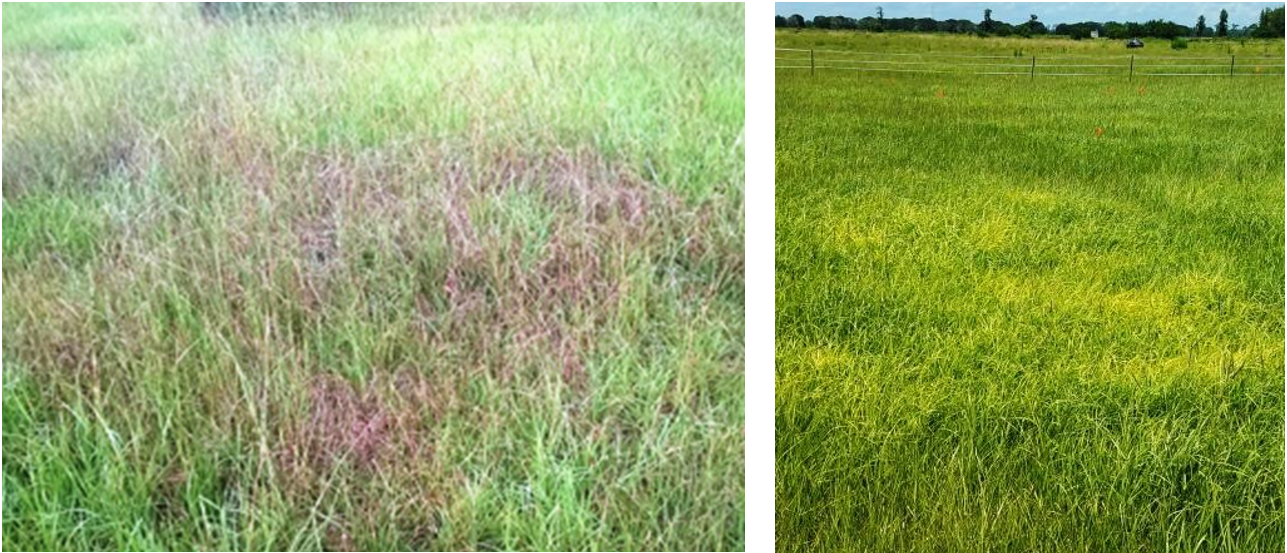
Nutrient deficiencies contribute to forage diseases. Leaf fungal disease symptoms (left) and Take-All root rot disease symptoms (right), in bahiagrass. Credit: Blount and Mackowiak.
Cheryl Mackowiak UF/IFAS Soil Specilaist, Ann Blount UF/IFAS Forage Breeder
As summer approaches, it is a good time to sample your soils and/or review your latest soil report, in order to review your pasture fertility management for the new growing season. University of Florida IFAS provides fertilization recommendations many forage and agronomic crops.
As part of our research and extension duties, state specialists have the opportunity to observe how soil fertility management in hay fields and pastures is performing across the state. Through the Florida Cattlemen’s Association Beef Enhancement sponsorship this past year, we have been able to collect a variety of forage and soil samples from ranch pastures and hay fields all across the state. The samples are being used to investigate soil-related factors that may lead to pasture decline and forage factors that may potentially affect livestock performance.
It is early in our investigations, but we would like to pass along a few soil fertility observations that may stimulate curiosity and questions about your own fields. A team of state and county extension specialists collected 32 soil samples from warm-season pastures as far south as Highlands county (near Lake Okeechobee), north to Nassau county, and west to Jackson county in the Panhandle.
Only 6% of our samples had pH < 5.5. One was in the sand ridge (Central FL) and the other was in new land converted from pine plantation in the Panhandle. In comparison, 31% of the samples had pH ≥7. None of the high pH soils were from the Panhandle, and most were from locations south of Gainesville, FL. Lime-stabilized sludge (biosolids) applications, for a time, would often exceed soil pH requirements. Over the past several years, most ranchers have modified their practices to eliminate lime-stabilized applications to affected lands and others have shifted to using Class AA biosolids, which do not have not land application restrictions beyond those of conventional fertilizer. Bahiagrass decline may sometimes be associated with high soil pH (chances increase above pH 6.5) and Take-All root rot disease has been associated with high pH soils.
Only 3% of sampled soils registered low phosphorus (< 25 ppm P), while 50% were excessively high (> 100 ppm P). We plan to sort out which high P soils reflected native phosphatic soils, over application of organic amendments, or over application of P fertilizers. There were examples of excessively high P soils across the state, which suggests that in many cases, the values were due to management, but not always. Excessive P fertilizer applications are not economical and high soil P can interfere with iron and zinc forage uptake and harm the environment when excess P enters surface or groundwater supplies. If your soil report shows at least 26 ppm P, your perennial grass will not need any further P fertilization.
Approximately 22% of soil samples were low in potassium (K), while 19% were excessively high (> 100 ppm K). High soil K is a waste of money, since it can accumulate in plants to levels beyond their requirements and in soil it is susceptible to leaching losses during high rainfall events. A mix of excessively low and high soil K was scattered across the state, representing differences in pasture management.
Approximately 50% of all soils had excessive calcium (>1,000 ppm Ca) and magnesium (Mg > 100 ppm). Often high soil Ca and/or Mg are associated with high soil pH. This was true in approximately 80% of the cases. Additionally, Ca, Mg, and K compete with one another for uptake. If soil Ca and/or Mg are high, it may interfere with K uptake. In 65% of the samples, soil K was less than 2% of the calculated cation exchange capacity (CEC) value (comprised of percent K+, Ca2+, Mg2+, and H+). These soils may lessen K uptake. A tissue sample to assess the forage K status might be valuable in this situation.
Somewhat surprisingly, 41% of total samples (53% of those from the Panhandle) were low (< 15 ppm S) in soil sulfur (S). In comparison, 19% were over 30 ppm S. The high S soils were in Central Florida and were often associated with high organic matter (OM) > 3%.
In terms of soil micro-nutrients, most manganese deficient soils were from central Florida, while most zinc (Zn) and copper (Cu) deficient soils were associated with pastures that were recently converted from pine plantation. Soil iron (Fe) was adequate across the state.
Take-Home Messages
If you recently converted land from pine plantation to pasture, your soil is likely deficient in most plant essential nutrients. If your land is in the Panhandle, you may find low to adequate soil pH, but also low K, Ca, S, and B fertility. Low soil K and/or S increases warm-season grass susceptibility to several fungal leaf diseases. If you are located on natural phosphatic soils (some places in Central to North-Central Florida), you may have excessive soil P and low Mn. If the land historically received repeated biosolids applications, then along with P, the pH and OM might be high. High pH, OM, and N and/or low soil Mn are conditions conducive to Take-All root rot fungus. The degree of harm varies by forage species and other conditions. Finally, do not guess on your soil fertility! Collect a composite sample (a mix of several samples from across the field) and have it analyzed for soil fertility and pH. Your county extension agent can provide you further sampling information and help with the soil report interpretation, at no charge. Please take advantage of their expertise.
- Grower Survey Insights on Cotton Nitrogen Management in Florida’s Panhandle - July 18, 2025
- Florida Soils are an Indispensable Natural Resource - January 10, 2025
- Regenerative Agriculture: What it Means to You - June 21, 2024
